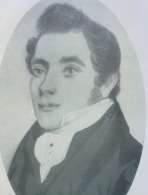John Bennie (missionary)
| John Bennie | |
|---|---|
 | |
| Born |
26 October 1796 Glasgow, Scotland |
| Died |
9 February 1869 (aged 72) Rosmead, Cape Colony, |
| Nationality | British |
| Occupation |
|
| Religion | Christian (Church of Scotland / Dutch Reformed Church) |
| Spouse(s) | Margaretha Magdalena Marè |
| Parent(s) | James Bennie and Margaret Scott |
| Ordained | 1831 |
John Bennie (1796, Glasgow - 9 February 1869, Ciskei) was a Presbyterian missionary and early Xhosa linguist.[1] In 1816 he became associated with the Glasgow Missionary Society while still in Scotland and[1] sailed to South Africa on the ship Woodlark as a catechist where he carried out his missionary work in the Ciskei.[1]
Missionary work
John Bennie is one of the founding fathers of the Lovedale Mission Station, which was established among the Ngqika.[2] Bennie resigned from his post at Lovedale due to the deteriorating health of his wife. He went on to establish a mission church for the Dutch Reformed Church in Middelburg.
In 1843, John Bennie was transferred by the Glasgow Missionary Society to the Burnshill Mission Station in British Kaffraria. The station had been established by the society in 1831.[3]

It was while Bennie was posted at Burnshill that he made the journey described in his book, An account of a journey into Transorangia and the Potchefstroom-Winburg Trekker Republic in 1843; edited by D. Williams,[4] into the interior of South Africa to administer to the spiritual needs of the voortrekkers with his father-in-law and brother-in-law.
Private life
John Bennie was the son of James Bennie, a metal smith from Glasgow, Scotland and Margaret Bennie (née Scott). Six years after arriving in South Africa, John Bennie married Margaretha Magdalena Marè (1801–1868) from Graaf Reinet. She was an Afrikaner of Huguenot decent. This fact was most probably why he got involved with the Dutch Reformed Church.[1] They had nine children together and also adopted another. 4 of his children were known to have been educated at Lovedale and his one son, John Angell became the boarding master and acting principal of the school after first teaching at another mission station for two years. Bennie died on 9 February 1869 at the age of 72.
Work on the Xhosa language
After learning Dutch, John Bennie went about learning Xhosa, his aim being in his words was “reducing to form and rule this language which hitherto floated in the wind”.
When John Ross (another missionary) brought a printing press to Tyhume in December 1823, John Bennie had already produced his transcription of the Xhosa language. The first sheets of printed Xhosa were produced on the 19th of December 1823. The oldest piece of printed continuous Xhosa known is Bennie’s Xhosa Reading sheet printed in 1823. On the 18 November 1824 Bennie announced to his Presbytery that he was going to compile an extended list of vocabulary and grammar dealing mainly with pronunciation of the Xhosa language. Through the Lovedale Press he was able to publish a number of vocabulary lists as well as publications on grammar dealing with pronunciation. .The 2nd edition of Kropf’s Dictionary of 1915 has incorporated into it Bennie’s manuscript portions of a “Kafir-English’’ (Xhosa-English) Dictionary. John Bennie also was involved in translating and transcribing the oral narrative of a Xhosa convert from the Tyhume mission, Noyi (Christian name: Robert Balfour). The narrative was called Iziqwenge zembali yamaXhosa (“fragments of Xhosa history”). Only part of this narrative was printed and was never published as a whole, but was still an important attempt at recording Xhosa history. It would have been the first secular Xhosa publication.
- Xhosa
- “Siyabulela thina basemaXhoseni
- Ngokufika kweento zooRose nezooBheni
- Ukuz’ amaXhos’ avulek’ ingqondo
- Kulo mhla yaqal’ ukubhalwa le ntetho
- Intethw’ engqongqotho yasemaXhoseni”
- English translation
- We Xhosa are ever grateful
- that men like Ross and Bennie
- came to ignite the mind of the Xhosa by first transcribing the language,
- the peerless language of the Xhosa
- Izibongo
Izibongo is a praise poem written in Xhosa. It was produced in 1985 by the Thembu poet (imbongi) D. L. P. Yali-Manisi at a university conference in Durban. Part of it praises and recognises John Bennie for his contribution to the written language.
See also
References
- 1 2 3 4 "Genealogyworld.net". Genealogyworld.net. Retrieved 2012-10-14.
- ↑ "The isiXhosa Language | about | language". Kwintessential. 2012-10-08. Retrieved 2012-10-14.
- ↑ "Imperial Networks: Creating Identities in Nineteenth-Century South Africa and Britain / by Alan Lester". Routledge, 2005. Retrieved 2015-04-16.
- ↑ "An account of a journey into Transorangia and the Potchefstroom-Winburg Trekker Republic in 1843 / by John Bennie ; edited by D. Williams | Miami University Libraries". Lib.muohio.edu. Retrieved 2012-10-14.